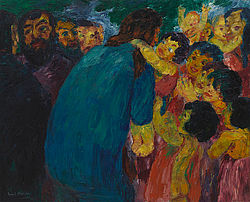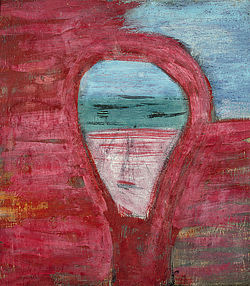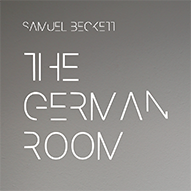English
Modern German art was a relative unknown for Beckett at the outset of his journey. During his two months in Hamburg, however, he became immersed in the contemporary art scene. He was introduced to art critics and historians, collectors, and artists, among them members of the Hamburger Sezession like Karl Ballmer, Rosa Schapire and Gretchen Wohlwill. From them, Beckett heard of the effects of the Nazi regime’s policies on artists and academics.
Beckett’s new connections also enabled him to view art that was otherwise being removed from public access. He visited Schapire’s “Wohnung full of Schmidt-Rottluff” (14/11/36), the private collections of H.C. Hudtwalcker and Max Sauerlandt, and the stacks of the Kunsthalle, where work deemed “degenerate” had been stashed.
 Emil Nolde, Christus und die Kinder (1910)
Emil Nolde, Christus und die Kinder (1910)
The Museum of Modern Art, New York / Scala, Florence
19/11/36
Suddenly Schapire & an official (Testorpf) at hand. I am to be shown the Magazin! […] Nolde’s Christus u. die Kinder, clot of yellow infants, at green back of Christ leading to black & beards of Apostles. Lovely eyes of child held in his arms. Feel at once on terms with the picture, & that I want to spend a long time before it, & play it over much like the record of a quartet.
Beckett’s experiences in Hamburg profoundly shaped his engagement with art. He picked up a keen interest in medieval sculpture and painting, and the conversation and work of the Swiss painter Ballmer influenced the fundamentals of Beckett’s thinking about themes such as the relationship between subject and object, surface and depth, or art and religion.
 Karl Ballmer, Kopf in Rot (ca. 1930/31)
Karl Ballmer, Kopf in Rot (ca. 1930/31)
Aargauer Kunsthaus, Aarau / Acquisition 1971 | Foto: Jörg Müller
26/11/36
Wonderful red Frauenkopf, skull earth sea & sky, I think of Monadologie & my Vulture. Would not occur to me to call this painting abstract. A metaphysical concrete. Nor nature convention, but its source, fountain of Erscheinung. Fully a posteriori painting. Object not exploited to illustrate an idea, as in say Léger or Baumeister, not primary. The communication exhausted by the optical experience that is its motive & content. Anything further is by the way. Thus Leibniz, Monadologie, Vulture, are by the way.
Deutsch
Mit moderner deutscher Kunst war Beckett zu Beginn seiner Reise vergleichsweise unvertraut. Während seiner zwei Monate in Hamburg tauchte er jedoch tief in die zeitgenössische Kunstszene ein. Er wurde Kunstkkritikerinnen, Kunsthistorikern und Künstlerinnen vorgestellt, unter ihnen Mitglieder der Hamburger Sezession wie Karl Ballmer, Rosa Schapire und Gretchen Wohlwill. Von ihnen erfuhr Beckett aus erster Hand von den Repressalien des nationalsozialistischen Regimes gegen Künstler und Intellektuelle.
Becketts neue Bekanntschaften machten es ihm auch möglich, Kunst zu besichtigen, die häufig bereits aus der Öffentlichkeit entfernt worden war. Er besuchte Schapires „Wohnung full of Schmidt-Rottluff“ (14/11/36), die privaten Sammlungen von H.C. Hudtwalcker und Max Sauerlandt und das Magazin der Kunsthalle, in dem Werke verwahrt wurden, die als „entartet“ erachtet wurden.
 Emil Nolde, Christus und die Kinder (1910)
Emil Nolde, Christus und die Kinder (1910)
The Museum of Modern Art, New York / Scala, Florence
Becketts Erfahrungen in Hamburg formten seine Auseinandersetzung mit Kunst erheblich. So entwickelte er ein ausgeprägtes Interesse an mittelalterlicher Bildhauerei und das Werk des Schweizer Malers Ballmer und Becketts Austausch mit ihm beeinflussten die Grundlagen seines Denkens über Themen wie die Beziehung zwischen Subjekt und Objekt, Oberfläche und Tiefe, oder Kunst und Religion.
 Karl Ballmer, Kopf in Rot (um 1930/31)
Karl Ballmer, Kopf in Rot (um 1930/31)
Aargauer Kunsthaus, Aarau / Ankauf 1971 | Foto: Jörg Müller
26/11/36
Wonderful red Frauenkopf, skull earth sea & sky, I think of Monadologie & my Vulture. Would not occur to me to call this painting abstract. A metaphysical concrete. Nor nature convention, but its source, fountain of Erscheinung. Fully a posteriori painting. Object not exploited to illustrate an idea, as in say Léger or Baumeister, not primary. The communication exhausted by the optical experience that is its motive & content. Anything further is by the way. Thus Leibniz, Monadologie, Vulture, are by the way.




